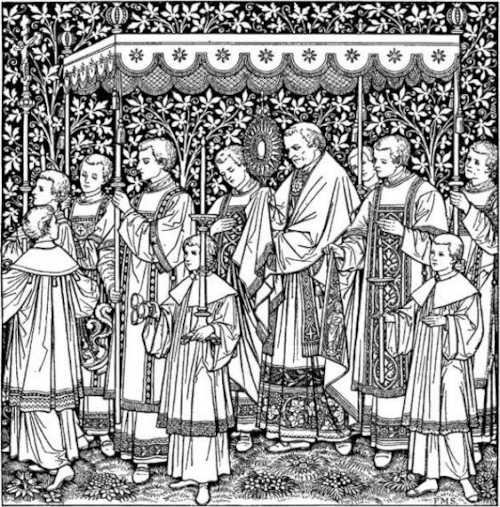
Last Sunday, 13,000 people were in the Sydney “Walk with Christ” procession on the Feast of Corpus Christi. Reading about this made me reflect on the Christian tradition of processions. In some of these processions we may not so conscious you actually are in a procession.
There is the procession of people from wherever they are – home, work, a motel… – to the church service. Those who will lead the service move in procession through the gathering congregation to lead us. This procession of ours, from our individual places to be joined together to be church together usually includes singing, often confessing our sins, and this gathering together culminates in being called to deep silent prayer concluded by the one presiding proclaiming the collect. We are now collected together to hear what the Spirit is saying to us the gathered church. [Some details of this procession are found here].
This procession really continues in the communion procession as we all move to receive Christ’s Body and Blood.
There is another procession – reversing the gathering one – as we go out to be Christ in the world. It is like breathing in and breathing out. The Eucharistic service is often called “Mass”, focusing on the dismissal (that is what ‘Mass’ means). A more recent dismissal is: “Go in peace, glorifying the Lord by your life.” It is called a “service” to energise us for service in the world. Liturgy means not only work of the people but it actually means work for the people – we, followers of Jesus, do this for all beyond church walls.
Christians not only have these processions, there is the procession for Corpus Christi, and also on Palm Sunday, and some process on Good Friday, and at other times.
At this time, I am particularly conscious of processions of refugees across countries…
The whole of Sydney’s Archbishop Anthony Fisher’s short reflection is worth reading. I will quote a part of it:
Arguably the biggest procession in history was that of the people of Israel, for it involved the whole nation and lasted for forty years. The line of Jews crossed through the sea, led by a pillar of cloud or fire and Moses with staff. As the procession went on, stone tablets with commandments on them led the way, and later ceremonial ark enclosed that stone law and the very presence of God. Soon they added trumpets and priests in special garb, poles to carry the ark, and elaborate decoration around it, and it would be brought even to the scene of battles. The procession celebrated Israel’s liberation from Egypt, the promises that God had made to them, and their undertakings back to Him.
What about our Eucharistic procession today? What does it say about what we believe? Well, first of all, it is a visible expression of the fact that we are Christians, followers of Christ, our way, truth and life (Jn14:6)—as we all followed behind Him today.
Secondly, our procession affirmed that the God we worship loved us so profoundly that He gave His only Son (Jn 3:16); so intimately, that that Son took flesh and dwelt among us (Jn 1:14); so totally, He gave up His life for us and for our salvation, foretelling and memorialising this by giving His Body and Blood to us in the Eucharist (Mt 26:26-29; Mk 14:22-25; Lk 22:19-20; Jn ch. 6; 1Cor 11:23-26). Here in the Eucharist we meet a God-man whose love for us is so total He would give us everything He is: His divinity and His humanity, His body and soul, His flesh and blood, His very substance and being to be part of ours.
Thirdly, our procession through the streets, past the office blocks and centres of commerce, the parliament and government buildings, the law courts, the hospital, the monuments to our history, past local families, tourists, those living on the streets, and all the rest, declares that Christ’s incarnation and eucharist is all for them, for everyone, and we prayed for those institutions and people that they might come to know, love and serve Him.
Archbishop Anthony Fisher OP
Promotional video:


